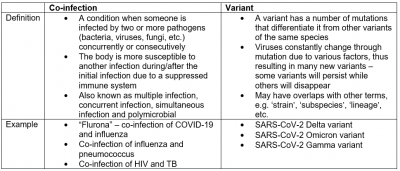Amidst the rise of the Omicron variant of COVID-19 late last year and early this year, you may have also heard of reports of “flurona” cases in certain countries. What is it and should we be concerned?
What is “flurona”?
“Flurona” basically refers to a co-infection of COVID-19 and seasonal influenza (also known as “flu”). The term first appears in the media in January this year in a news article about a pregnant woman in Israel who was infected with both viruses at the same time. It was claimed as the first case of “flurona” in the country at the time.
In fact, the term is simply a catchy name coined by the media by combining the two words – “influenza” and “coronavirus” – to hype up the story. “Flurona” is not an official or scientific term to describe the co-infection and certainly not a type of new “supervirus” as some people may believe.
Co-infection or variant?
To clarify, “flurona” is NOT a new COVID-19 variant. So what makes “flurona”, a type of co-infection, different from COVID-19 variants like Delta and Omicron?

Should I be worried?
To answer this question, we need to know how prevalent it is and how dangerous the possible outcomes or complications are.
Prevalence
Firstly, COVID-19 and influenza co-infection cases are not new and have been recorded even before “flurona” was coined. In fact, it was seen in some of the earliest COVID-19 cases, for example, in February 2020, when a man and his whole family in New York were tested positive with both influenza and COVID-19. Even the world’s first known COVID-19 death outside of China, which was in the Philippines, also had both COVID-19 and influenza. Children have been also reported to have the condition in the United States.
A systematic review published in June 2021 estimated that 4.5% of COVID-19 patients in Asia also had influenza. The study also found a prevalence of 4.6% of COVID-19 patients over 50 years old with influenza co-infection. However, it should be noted that the numbers may be underestimated because a co-infection would only be identified if a patient was specifically tested for both viruses, which is unlikely if the patient was not hospitalised.
Furthermore, experts are predicting that the prevalence may increase this year due to the rise in Omicron cases which coincides with the onset of the influenza season in some countries. On top of that, other factors such as increased social mixing after prolonged lockdowns, low influenza vaccination rates and potential mismatch of influenza vaccine strain could also contribute to higher cases.
Severity
Both viruses tend to infect the same type of cells in the upper and lower respiratory tracts, thus similar symptoms are usually observed. The most common symptoms experienced by people with COVID-19 and influenza co-infection include fever, cough, shortness of breath, muscle ache and breathing difficulty.
Typically, any co-infections may worsen complications and increase death, especially among high-risk populations, such as the elderly, children below 5 and people with underlying illnesses. An animal study showed that pre-infection with influenza A virus may enhance SARS-CoV-2 infection in mice, leading to worse outcomes. However, there is still inadequate data to determine whether real life cases will cause more severe complications.
What should I do?
Both COVID-19 and influenza are serious illnesses on their own. And both have the same route of transmission, i.e. via respiratory droplets. Thus, it is important to continue practising preventive measures such as wearing masks, physical distancing, frequent hand-washing and proper ventilation. Also remember to protect yourself and your loved ones by getting the COVID-19 vaccine and the annual influenza shot.
The COVID-19 pandemic is still far from over and an influenza outbreak is always around the corner – in fact, there was an upsurge of influenza cases in Malaysia at the end of last year and early this year, raising the concern of “flurona” locally. Thus, the best course is to stay vigilant, no matter whether the threat comes from any one of the viruses or both as a co-infection.






Comments